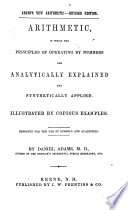 | Nathan Daboll - 1841 - 250 pages
...than the number expressing the place of the terms sought. 3. Multiply the terms of the geometrica. series together belonging to those indices, and make,...Raise the first term to a power whose index is one Iess than the number of the terms multiplied, and make the result a divisor. 5. Divide, and the quotient... | |
 | Daniel Adams - 1848 - 316 pages
...term, ratio, and number of terms being given, to find the sum of the series, RULE. Raise the ratio to a power whose index is one less than the number of terms, from which subtract 1, and divide the remainder by the ratio less 1 ; the quotient is the sum of a... | |
 | Nathan Daboll - 1844 - 254 pages
...than the number expressing the place of the terms sought. 3. Multiply the terms of tlie geometrica. series together belonging to those indices, and make...a power whose index is one less than the number of the terms multiplied, and make the result a divisor. 5. Divide, and the quotient is the term sought.... | |
 | James Bates Thomson - 1844 - 272 pages
...continued proportion, the ratio of the first to the last is equal to one of the intervening ratios raised to a power whose index is one less than the number of quantities. If there are four proportionals a, b, c, d, then <i:d::a3:63 If there are five a, J, c,... | |
 | Samuel Alsop - 1846 - 300 pages
...divisor to be used in all the subsequent parts of the operation, raise the root already determined to a power whose index is one less than the number of the root to be extracted, and multiply by said number. Divide the first term of the remainder by the... | |
 | Jeremiah Day - 1847 - 358 pages
...continued proportion, the ratio of the first to the last is equal to one of the intervening ratios raised to a power whose index is one less than the number of quantities. If there are four proportionals a, b, c, d, then a : d : : a 3 : b 3 If there are five... | |
 | Daniel Adams - 1848 - 322 pages
...term, ratio, and number of terms being given, to find the sum, of the series, RULE. Raise the ratio to a power whose index is one less than the number of terms, from which subtract 1, and divide the remainder by the ratio less 1 ; the quotient is the sum of a... | |
 | Samuel Alsop - 1848 - 336 pages
...divisor to be used in all the subsequent parts of the operation, raise the root -already determined to a power whose index is one less than the number of the root to be extracted, and multiply by said number. Divide the first term of the remainder by the... | |
 | Jeremiah Day, James Bates Thomson - 1848 - 264 pages
...continued proportion, the ratio of the first to the last is equal to one of the intervening ratios raised to a power whose index is one less than the number of quantities. If there are four proportionals a, b, c, d, then a:d::a3:b3 If there are five a, b, c,... | |
 | Uriah Parke - 1849 - 414 pages
...the first term, ratio, and number of terms, we can readily find the last term by involving the ratio to a power whose index is one less than the number of terms, and multiplying this result by the first term. So from understanding the composition of the series,... | |
| |